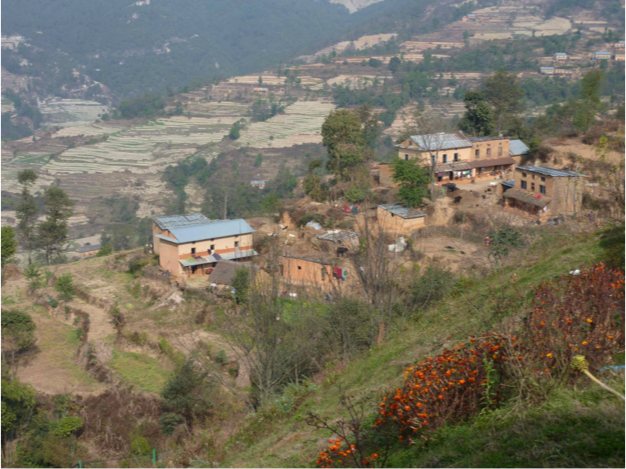
Manung is a small village in the Tanahun district of Nepal. Source: PANDEY (2012)
In the area of Manung VDC, several factors lead to water stress: For one part, precipitation varies strongly during the year with eight dry months being replaced by four months of monsoon, leading to surplus water. Furthermore, a high proportion (over 90 per cent) of the inhabitants practice substistance agriculture (see also linking up sustainable sanitation water management and agriculture, optimisation of water use in agriculture, reuse in agriculture and conservation of soil moisture). As almost every of these households owns livestock, there is excess need for water. Supporting institutions and specific knowledge for action are lacking, but would be necessary in order to tackle this problem (see also developing human resources).
In this case, you will look at the Manung scenario more closely: In groups, you will discuss and work out possible solutions for the problems related to water and present them to the whole class.
Local Responses to Too Much and Too Little Water in the Greater Himalayan Region
The Himalayan region has always had either too much or too little water. Today, however, it experiences a large range of changes due to climatic shifts. This report presents people’s efforts to respond, cope, and adapt to those alterations.
ICIMOD (2009): Local Responses to Too Much and Too Little Water in the Greater Himalayan Region. Kathmandu, Nepal: International Centre for Integrated Mountain Development (ICIMOD) URL [Accessed: 27.09.2012]Engineers Without Borders
A case study of a rural village in the Indian state Tamil Nadu focusing on alternative sources of water because of depleting groundwater and pollution of the nearby rivers.
OLSEN, D. CAMPBELL, C. (2009): Engineers Without Borders. Rainwater Harvesting Case Study. Ontario, Canada: Waterloo Faculty of EngineeringWater Related Stress in Nepal
The Feasibility of Rainwater Harvesting in the Rural Areas of Beijing
Is rainwater harvesting an attractive alternative to groundwater use for rural areas? These slides follow the question of the feasibility of precipitation harvesting for farmers in the area around Beijing, China.
XIAO, L. (2009): The Feasibility of Rainwater Harvesting in the Rural Areas of Beijing. Delft, The Netherlands: URL [Accessed: 27.09.2012]Application of Appropriate Technology for Rural Water Supply
Application of appropriate rural water supply methods is an important precondition to achieve universal access to safe water for all. This paper gives an overview on low cost traditional techniques experiences by UNICEF operations in developing countries.
ZELENIKA, M. (1991): Application of Appropriate Technology for Rural Water Supply. In: Rudarsko-geolosko-naftni zbornik: Volume 3 , 85-88. URL [Accessed: 27.09.2012]


